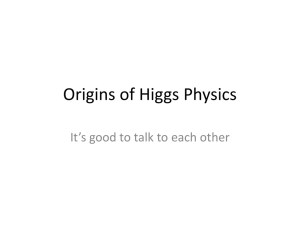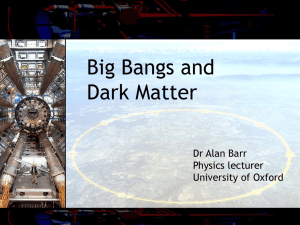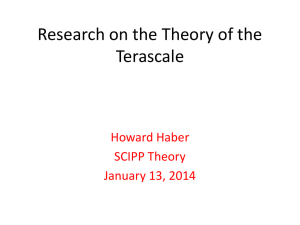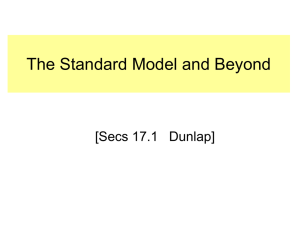Index
advertisement
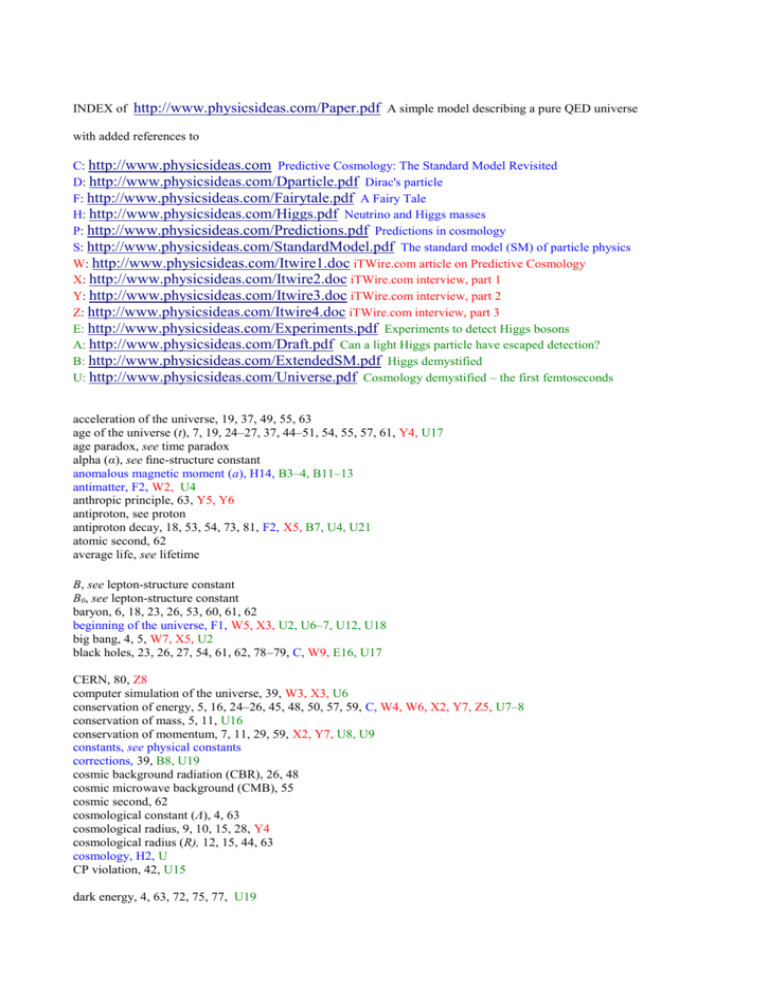
INDEX of http://www.physicsideas.com/Paper.pdf A simple model describing a pure QED universe with added references to C: http://www.physicsideas.com Predictive Cosmology: The Standard Model Revisited D: http://www.physicsideas.com/Dparticle.pdf Dirac's particle F: http://www.physicsideas.com/Fairytale.pdf A Fairy Tale H: http://www.physicsideas.com/Higgs.pdf Neutrino and Higgs masses P: http://www.physicsideas.com/Predictions.pdf Predictions in cosmology S: http://www.physicsideas.com/StandardModel.pdf The standard model (SM) of particle physics W: http://www.physicsideas.com/Itwire1.doc iTWire.com article on Predictive Cosmology X: http://www.physicsideas.com/Itwire2.doc iTWire.com interview, part 1 Y: http://www.physicsideas.com/Itwire3.doc iTWire.com interview, part 2 Z: http://www.physicsideas.com/Itwire4.doc iTWire.com interview, part 3 E: http://www.physicsideas.com/Experiments.pdf Experiments to detect Higgs bosons A: http://www.physicsideas.com/Draft.pdf Can a light Higgs particle have escaped detection? B: http://www.physicsideas.com/ExtendedSM.pdf Higgs demystified U: http://www.physicsideas.com/Universe.pdf Cosmology demystified – the first femtoseconds acceleration of the universe, 19, 37, 49, 55, 63 age of the universe (t), 7, 19, 24–27, 37, 44–51, 54, 55, 57, 61, Y4, U17 age paradox, see time paradox alpha (α), see fine-structure constant anomalous magnetic moment (a), H14, B3–4, B11–13 antimatter, F2, W2, U4 anthropic principle, 63, Y5, Y6 antiproton, see proton antiproton decay, 18, 53, 54, 73, 81, F2, X5, B7, U4, U21 atomic second, 62 average life, see lifetime B, see lepton-structure constant B0, see lepton-structure constant baryon, 6, 18, 23, 26, 53, 60, 61, 62 beginning of the universe, F1, W5, X3, U2, U6–7, U12, U18 big bang, 4, 5, W7, X5, U2 black holes, 23, 26, 27, 54, 61, 62, 78–79, C, W9, E16, U17 CERN, 80, Z8 computer simulation of the universe, 39, W3, X3, U6 conservation of energy, 5, 16, 24–26, 45, 48, 50, 57, 59, C, W4, W6, X2, Y7, Z5, U7–8 conservation of mass, 5, 11, U16 conservation of momentum, 7, 11, 29, 59, X2, Y7, U8, U9 constants, see physical constants corrections, 39, B8, U19 cosmic background radiation (CBR), 26, 48 cosmic microwave background (CMB), 55 cosmic second, 62 cosmological constant (Λ), 4, 63 cosmological radius, 9, 10, 15, 28, Y4 cosmological radius (R), 12, 15, 44, 63 cosmology, H2, U CP violation, 42, U15 dark energy, 4, 63, 72, 75, 77, U19 dark matter, 54, U17 deceleration, 37, 63 decoupling temperature, 55 degrees of freedom, 5, 8, 50, 69, U9, U10 Dirac particle (D), 7, 24, 47, 51, 57, 58, D1, F1, X3, Y2, Y3, U2, U6–7, U12, U18 Dirac’s large-number hypothesis (LNH), 4, 5, 8, 47, 63, 73, U17, U19 Dirac’s new equation, 4, 5, 7, 16, 27, 47, 51, 57, 58, D1, F1 Dirac’s spinor equation, 7, 15, 17 direction indeterminacy, 6 distance indeterminacy, 6, C, Y4, U11 double-slit experiment, 35 electric force, U16 electromagnetic force, U16 electron generation, 52 electroweak theory, see weak force energy principle, 1, 6, 26, 48, 50 EPR paradox, 35, 60, U12 evolution of the universe, H13, W6–7, W9, B6, U2, U6 exotic matter, 25, 42 expansion, 4, 5, 8, 9, 12–15, 24, 26, 28, 37, 51, 54, 59, 62, U9 extended standard model (xSM) of particle physics, S4–5, X2, E2, B1, U1 family structure of particles, H15 Fermi coupling constant (GF), 23, E3, U21 Feynman diagram or graph, 20, 35 fifth force, 55, 63, 69 fine-structure constant (α), 11, 38, 48, 63, Y5, Y6, U6, U11 finite QED (JBW hypothesis), 4, 7, 22, H3, B1, U12 flyby anomaly, E14 forces, W7, W9, U16 four momentum, 59, 66 frozen particles, see stationary particles fundamental hydrodynamic equation, 7, 29, U9, U10 Furry's theorem, A3, B4 gamma-ray burst, E15 general relativity, C GF, see Fermi coupling constant global picture, 26, 27, 48, 49, 54, 55, C, W4, U6 gluon, 60 grand unified theory (GUT), 18 gravitational lensing, see microlensing gravitational potential, 4, 5, 13, 36 graviton, Y2, U21 gravity, 4, 5, 8, 9, 12, 14, 15, 26, 27, 36, 54, 55, 61–63, W9, Y2, U9 hadroweak interactions, H9, X5 heat, U16 Higgs boson, 6, 23, 33 Higgs correction, 6, 23, 25, 33, 34, 38, 47, 56, Y4, E1–2, B Higgs detection, Z6-9, E1–20, U14 Higgs force, 53, H4, E18, U21 Higgs ghost, Z4, U14, U21 Higgs mass, H4, Z6, E2, E19, A5–6, U13, U21 Higgs mechanism, S3, Z5, B8, U17 Higgs-neutrino mechanism, H10, S4, Y5, Z2, Z5, B6, U3, U20 Higgs optics, Z7, E3 horizon of the universe, 16, 27, 36 Hubble expansion rate (H), 5, 6, 12, 14, 19, 37, 49, U17 hydrodynamic equation, 29 infinity, 7, 15, 72, 75 inflationary hypothesis, Y7 inflationary phase, X5 intrinsic parity, 41, 60, U3, U13–14 JBW hypothesis, see finite QED kaon decay, see superweak effect Klein-Gordon equation, 17 Large Hadron Collider (LHC), 80 large-number relation, 14 lepton generations, 53 lepton mass, A7 lepton-structure constant B, 10, 11, 31, 48, C, W8, Y7, U11 lepton-structure constant B0, 16, 48 lifetime (τ), 24, 26, 27, 45, 51, 63, U6, U8, U12 lifetime calculation, 48 literally nothing, 5, 16, 44, 50, 51, 57, C, W5, Y2, U12 local picture, 26, 49, 54, C, W4, U7, U8 low-temperature hydrodynamics, X5 LSP, 25, 42, 81 mass, see origin of mass mass spectrum, E3, U13 matter-antimatter asymmetry, X5 matter-antimatter symmetry, X5 matter-building particles, A1 matter-carrying particles, A7 matter-creating forces, 40, W7, U16 maximum simplicity, see simplicity mean life, see lifetime microlensing, 26, 27, 78–79, E16 microwaves, U13, U14 molecules, 8, 11, 55, 68, U10 momentum equation, 11, 27, 29, 50, 56–59, 67, C, W2, X3, X5, Y7, U9, U10 multiverse, 63, 72, 75 muon-electron mass ratio, 5, 6, 11, 17, 22, 25, 27, 40, 47, 48, 56, C, W1, W3, W8, U6, U11 muon g–2 experiment, B3–4, U14 muon generation, 52 natural unit of time (tc), Y7, U2, U12, U17 neutrino correction to lepton mass, Y4 neutrino mass, H5, Y4, Z6 neutrino oscillations, H11, Z3, U14, U16, U20 neutron, 26, 48, 61 Newton’s second law, 29, 69, U9, U10 nothing, see literally nothing nucleosynthesis, 4, 18, 27 origin of mass, Z10, B7, U16 orthopositronium decay, 59 parapositronium, 41 parity, see intrinsic parity parity violation, 42 path integral, 17, 21, 35, 48 photon, 20 photon-baryon number ratio, 6, 18, 23, 26, 53, 54, 61 photon versus Higgs boson, E18, B7, U13, U16 physical constants, E20 pion, 52, 59, 60, W7 pion parenthesis, H3 Pioneer anomaly, C, Z9, E13, B4–5, U14 Planck constant (h), 24, 45, 62 Planck time, 55, 62, 63 Planck’s quantum of action, 62, 71 pointless space, 6, 15, 16, 35, 54, 55, U11 position undefinability, 50, 67, U11 positron, 7, 20, 22, 48 positronium decay, H12, Z8 predictions in cosmology and particle physics, P1–6, X2, X6 pressure, 8, 11, 15, 58, 68 pressureless hydrodynamic equation, see momentum equation principle of maximum simplicity, see simplicity proton, 6, 18, 19, 22, 23, 25, 26, 28, 52, 61, W7 proton decay, 18, U21 pulsar, E17 pure QED, see finite QED QCD, see strong force QED, see finite, scalar, spinor QED QED universe, U1 quantum gravity, 15, 28, 55 quantum indeterminacy, 6, 55 quark, 53, 59–61, 79 quark families, 53 quintessence, 4, 63, 75, U19 radius of the universe, see cosmological radius redshift, 16, 19, 23, 24, 37 scalar QED, 20, 51, 52, 58, 62, W6, U12 Schrödinger’s cat, 51, 58 simplicity, 4, 5, 7, 35, 35, 46, 48, 51, 52, 57, 59, 62, X4, X5, Z10, U12, U21 simulation experiment, 1, 6, 24, 27, 44, 50, 57, 58, 63, U6 singularity, 4, 37, 70, 72, 75 sizeless leptons, 35 space, see pointless space space equation, C, W2, U10 spacetime, 10, 24, 44, 47, 51, U16 spectrum, E3, U13 spinor QED (or QED), 20, 28, 52, 62, W6, U12 spooky action at a distance, 49, 54, 60, 67, U8, U12 standard model of cosmology, S1 standard model (SM) of particle physics, 7, 23, 33, 72, C, S2 stationary particles, U7, U10 string theory, 10, 59, 74, Y3 strong force, 5, 6, 16, 18, 22, 53, 55, 60, U16 superfluid, X5 supernova, see type Ia supernova supersymmetry (SUSY), 25, 28, 42, 81, Y3 superweak effect, 42, 43, U15 symmetry-breaking events, H6 tau (τ), see lifetime tauon, 57 tauon generation, 51 tauon-muon mass ratio, 17, 24, 25, 27, 48, 56, 59 temperature, 5, 8, 11, 15, 16, 18, 26, 28, 48, 51, 54, 54, 60, 61, U16–17 theory of everything (TOE), U1 time paradox, 6, 20, 50, 54, 55, 60, 63, 71, C time unit, see natural unit of time true muonium, Z8 true tauonium, Z8 type Ia supernova, 63 uncertainty principle, 62 universe, see beginning, evolution of the universe vacuum-polarization (v-p) loop, 7, 20, 22, U1 W boson, H5, Z5, U3 weak force, 5, 6, 16, 18, 22, 25, 33, 38, 47, 55, 59, 60, Y4, U16 xSM, see extended standard model of particle physics Z boson, H4, Z5, U3, U20 iTWire contents Contents of a series of four articles written by William Atkins and published by iTWire.com between 10 August 2009 and 03 March 2010 Original article: August 10, 2009 iTWire.com article “Predictive Cosmology: Creation's secret revealed mass ratio = 206.768 283” (or, http://www.itwire.com/content/view/26822/1066/) W-1 W-2 W-3 W-4 W-5 W-6 W-7 W-8 W-9 in muon-electron Fundamental questions that a theory for the universe should be able to answer Space and the momentum equation An initially cold and matter-antimatter symmetric universe Higgs bosons lighter than the electron The muon-electron mass ratio Conservation of energy provides constraints that make cosmology predictive The law of conservation of energy applies both locally and globally The beginning of the universe Phase 1: The D particle and spinless tauons Phase 2: Spinless muons described by scalar QED Phase 3: A pure QED universe inhabited by electron-positron pairs and photons Phase 4: The appearance of the strong and weak forces and their particles What the four terms of the muon-electron mass ratio reveal Summary of questions answered by the theory - What makes the universe expand? - How was the very first particle created? - How were today's massive elementary particles created? - Why are there electromagnetic, strong, and weak forces? - When did the forces first appear? - Why did not matter and antimatter completely annihilate each other? First interview: December 21, 2009 iTWire.com article “Predictive http://www.itwire.com/content/view/30199/1066/) Cosmology and Standard Model revisited” (or, X-2-1 X-2-2 X-2-3 X-2-4 X-3-1 X-3-2 X-3-3 X-3-4 X-3-5 X-3-6 X-4-1 X-4-2 X-4-3 X-5-1 X-5-2 X-6-1 X-6-2 How can you know that your theory (xSM) is correct? Where have you summarized the theory's explanations and predictions? Why did you choose the term “extended SM” SM as the name of your theory? What is the basis for the detailed predictions of xSM? How does xSM explain the beginning of the universe we observe today? When does the primordial particle appear? And what was there before? Why wasn't the role of Dirac's new particle immediately understood? Why was the idea of space being a fluid-like medium abandoned? Why is the pressureless form of the momentum equation crucial? What is the second reason that it is so crucial for our understanding of space? Is xSM really as simple as you've indicated? Why hasn't your theory met with enthusiasm? With whom have you discussed your theory? What is xSM's explanation of the matter-antimatter asymmetry? Why is it unwelcome? Could the “pressureless momentum equation” find use in practical physics? Would you mind recounting predictions made by xSM? Why don't you write a brief, up-to-date version of your paper? Second interview: January 9, 2010 iTWire article “Q&A Interview, Part 2: Predictive Cosmology and revisited” (or, http://www.itwire.com/content/view/30398/1066/) Y-2-1 Y-2-2 Y-2-3 Y-3-1 Y-3-2 Y-4-1 Y-4-2 Y-4-3 Y-5-1 Y-5-2 Y-6-1 Y-6-2 Y-6-3 Y-7-1 Y-8-1 What does xSM say about gravity? Do gravitons exist? If gravitons exist, when did they first appear? What about supersymmetry? What about the number of dimensions (in superstring or M theory)? What was the universe's initial radius? Haven't protons always existed as virtual (if not necessarily as real) particles? How can xSM be tested? Is it possible to calculate alpha within xSM? What advice would you give to somebody attempting to compute alpha? Will you once again try to calculate the lepton mass ratios and alpha? When would you believe in an algorithm pretending to compute alpha? What aspects of the xSM theory are you presently focusing on? What will happen to the theory when you no longer pursue it? Might this be an opportunity for students who want to be forerunners in a new theory? Third interview: March 3, 2010 iTWire article “Q&A Interview, Part 3: Predictive revisited” (http://www.itwire.com/science-news/energy/37280-xsm3) Z-2-1 Z-2-2 Z-3-1 Z-3-2 Z-4-1 Z-4-2 Z-5-1 Z-5-2 Z-5-3 Z-5-4 Z-6-1 Z-6-2 Z-6-3 Z-7-1 Z-7-2 Standard Model Cosmology and Standard Model Let's discuss weak interactions, Higgs bosons, and neutrinos within the context of xSM. Where have you summarized your latest insights about weak interactions? Can xSM shed light on neutrino oscillations? How do the predictions of xSM match the observed neutrino oscillations? Isn't your paper's prediction of four physical Higgs bosons experimentally refuted? What are Higgs ghosts? Please elaborate on the “hadroweak end of the transport line.” What ideas have led to the new understanding of weak interactions? How do the Higgs-neutrino and the “hot Higgs” mechanisms differ? Can you explain the “hot” vs. “cold” Higgs mechanisms in more detail? How can the Higgs and neutrino masses be calculated, and what are they? Shouldn't it be a straightforward task to detect the flyweight Higgs boson? Do you think it's possible in a simple “home experiment?” What if your proposed experiment shows no sign of Higgs bosons? How could the Higgs mass be precisely measured? Z-8-1 Z-8-2 Z-8-3 Z-9-1 Z-9-2 Z-9-3 Z-10-1 Z-10-2 Z-10-3 Z-10-4 What about advanced experiments using particle accelerators? What about ongoing Fermilab and CERN searches for very heavy Higgs bosons? What about Higgs bosons emitted by quarks? Have the Higgs bosons already shown up without being recognized? Shouldn't photons traversing the atmosphere exhibit a “Higgs delay?” How can a “Higgs delay” of microwaves cause a “Pioneer anomaly?” Why should we believe in xSM and its prediction of very light Higgs bosons? Why should the principle of maximum simplicity be adhered to in physics? How are particle masses generated if not via the so-called Higgs mechanism? May the Higgs mass be affected by “new physics?” Updated on 2011-04-10/stigS
